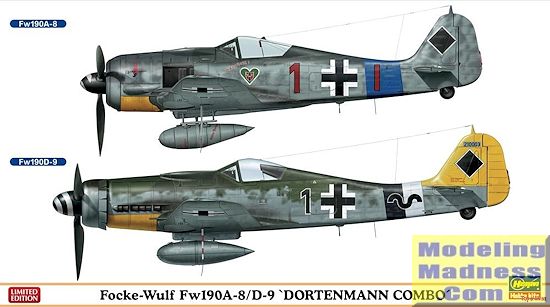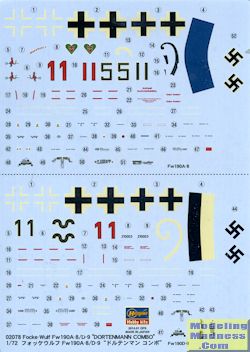
Hasegawa 1/72 FW-190A-8/D-9 "Dortenmann Combo"
| KIT #: | 02078 |
| PRICE: | 3020 yen (a bit less than $25) direct |
| DECALS: | Two options per plane |
| REVIEWER: | Scott Van Aken |
| NOTES: | Two complete kits |

| HISTORY |
Hans Dortenmann was born 11 December 1921 at Weingarten. He served in the infantry until April 1941 when he transferred to the Luftwaffe to undergo pilot training. After training Leutnant Dortenmann was posted to Jagdgeschwader 54 on the Northern sector of the Eastern Front.
He gained his first victory on 6 February 1944, colliding with a Lavochkin La-5 fighter. Dortenmann managed to belly-land his damaged Fw 190A-6 on his return to base. In June 2./JG 54 was withdrawn and relocated to the Western Front, joining III./JG 54. Dortenmann had claimed some 14 victories by this and on 20 June 1944 was promoted to Staffelkapitän of 2./JG 54. The unit was then redesignated 12./JG 54. Dortenmann was shot down near Paris on 26 June but managed to bale out.
Over the Western Front Dortenmann claimed six fighters shot down. In mid-August, III./JG 54 was withdrawn to Germany to received the new Fw 190 D-9 "Dora-9", becoming operational in October. 12./JG 54 and Leutnant Dortenmann were based at Achmer to fly airfield protection cover for the Me 262 jet fighters of Kommando Nowotny. On 29 December Dortenmann shot down a Spitfire near Münster. Dortenmann was made acting Gruppenkommandeur of III./JG 54 on 30 December.
On 25 December, III./JG 54 was placed under operation command of Major Karl Borris with I./JG 26 for Operation Bodenplatte. On 1 January 1945, Dortenmann led III./JG 54 against Brussels-Grimbergen airfield, from which 12 Fw 190s failed to return. 12./JG 54 was thus disbanded on 19 February 1945 with aircrew distributed throughout III./JG 54. Dortenmann now took command of 11./JG 54. In late February, III./JG 54 was absorbed into JG 26 with 11./JG 54 becoming 14./JG 26.
On 29 March 1945 Oberleutnant Dortenmann became Staffelkapitän of 3./JG 26 and awarded the Ritterkreuz on 20 April for 35 victories. On 27 April Dortenmann shot down a Soviet Yak-3 over Berlin. Hans Dortenmann survived the war but died on 1 April 1973.
Hans Dortenmann was credited with 38 victories in some 150 combat missions, with 16 victories over the Eastern Front and 22 over the Western Front. He recorded 18 victories with the Fw 190 D-9,the most successful fighter pilot with this type.
He possibly claimed the Tempest V shot down of French ace Pierre Clostermann on 28 march 1945.
| THE KIT |
Hasegawa seems to have hit on a rather successful way of marketing its large inventory of kits by doing double boxings. Often the kits are the same, but equally frequent are ones such as this where there are two different kits included. Some of these combos have three or even four kits. It seems to be a rather successful series as most offerings sell out rather quickly.
Hasegawa's FW-190A and FW-190D-9 are no strangers to your editor and I assume to most of you. Though superseded by newer mold kits, they have the benefit of being pretty straight-forward, non-fiddly kits that have the proper shape we want and room for aftermarket bits if one is so inclined.
In both cases the cockpit is rather basic and uses decals for instruments. Depending on the boxing, there are a multitude of holes in the lower wing for various weapons and racks that can be opened up. The only things under wings for these kits are drop tanks. Landing gear is sturdy but is a bit of a loose build so one has to take some care when assembling this. A separate windscreen and canopy are provided. The D-9 has both the early and later versions of the canopy with the differing head rests. On both kits, the prop blades are separate and attach to either a fan housing or a flat plate, again, depending on the kit being built.
 Hasegawa
provides two sets of instructions and each set has two markings options. All the
paint references are for Gunze paints. The FW-190A-8s are both in RLM 74/75/76
and have blue tail bands. These are provided as decals though you may wish to
paint them. The box art plane has a black spinner with abbreviated white spiral
along with a yellow lower cowling. This plane was with 2./JG 54 in June of 1944
in France. The other is also from June 1944 and with 8./JG 54. It does not have
the lower yellow cowling but has a white spinner with black spiral. For the
FW-190D-9, the two options have a yellow fin and rudder along with the lower
engine cowling. Both have black spinners with white spirals. The box art plane
is from March 1945 and is painted in RLM 82/83/76. This is the 14./JG 26 plane
and has the black and white fuselage band. The other is without the fuselage
band and with 12./JG 54 in October of 1944. It is painted in 75/83/76 and has
the earlier canopy as the 'blown' canopy was not available until January 1945.
The decals are nicely printed and
include stencils.
Hasegawa
provides two sets of instructions and each set has two markings options. All the
paint references are for Gunze paints. The FW-190A-8s are both in RLM 74/75/76
and have blue tail bands. These are provided as decals though you may wish to
paint them. The box art plane has a black spinner with abbreviated white spiral
along with a yellow lower cowling. This plane was with 2./JG 54 in June of 1944
in France. The other is also from June 1944 and with 8./JG 54. It does not have
the lower yellow cowling but has a white spinner with black spiral. For the
FW-190D-9, the two options have a yellow fin and rudder along with the lower
engine cowling. Both have black spinners with white spirals. The box art plane
is from March 1945 and is painted in RLM 82/83/76. This is the 14./JG 26 plane
and has the black and white fuselage band. The other is without the fuselage
band and with 12./JG 54 in October of 1944. It is painted in 75/83/76 and has
the earlier canopy as the 'blown' canopy was not available until January 1945.
The decals are nicely printed and
include stencils.
| CONCLUSIONS |
These combo boxings are a nice way to get a couple of nice kits for a reasonable price. Even if you decide to use aftermarket decals, the kits inside will make into very nice models.
| REFERENCES |
https://en.wikipedia.org/wiki/Hans_Dortenmann
November 2015
Copyright ModelingMadness.com
Thanks to your editor for buying this one.
If you would like your product reviewed fairly and fairly quickly, please contact the editor or see other details in the Note to Contributors.